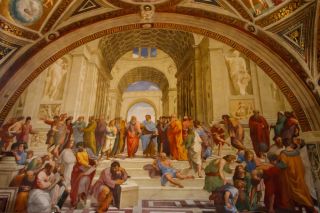Philosophy
How the Western Mind Nearly Took an Eastern Turn
The striking similarities between Greek and Indian thought.
Updated June 16, 2024 Reviewed by Jessica Schrader
Key points
- Like the Indian ascetics of his time, Pythagoras believed in reincarnation and vegetarianism.
- In arguing that the universe is a single entity, Parmenides echoed the Upanishads.
- Plato, the father of Western philosophy, was deeply influenced by both Pythagoras and Parmenides.

In antiquity, Pythagoras was better known as a philosopher than a mathematician. Although he may have introduced it to the West, the theorem that came to bear his name had been discovered centuries earlier by the Babylonians and Indians. His association with this theorem suggests some kind of Eastern connection.
Pythagoras
Pythagoras of Samos (c. 570-c.495 BCE) was a near contemporary of Anaximander and Anaximenes, as well as the Buddha. He might even have met Thales of Miletus—"the first scientist”—who, it is said, advised him to travel to Memphis to take instruction from Egyptian priests.
At the age of 40, Pythagoras left Samos for Croton in southern Italy, where he established a philosophically minded religious community. Unusually for the time, Pythagoras admitted men and women alike. Of the 235 famous Pythagoreans listed by Iamblichus, 17 are women.
The men and women who entered the community’s inner circle were governed by a strict set of ascetic and ethical rules, forsaking personal possessions, assuming a mainly vegetarian diet, and—since words are so often careless and misleading—observing the strictest silence.
In India, at around the same time, the Buddha’s followers were organizing into monasteries. The Buddha delivered many of his discourses in the monastery of Jetavana in Shravasti, which had been donated to him by the banker Anathapindada. Buddhist monks could eat meat if it was offered to them, but only after ensuring that the animal had not been slaughtered on their behalf. At her insistence, the Buddha’s aunt Mahapajapati became the first of many Buddhist nuns.
The first Buddhist monasteries served as a prototype for the world’s first residential university at Nalanda, just as Protagoras’ community served as a model for philosophical institutions such as Plato’s Academy and Aristotle’s Lyceum, and, later, for the monastic life and associated early universities.
Music played an important role in Pythagoras’ community. Pythagoreans recited poetry, sang hymns to Apollo, and played on the lyre to cure illnesses of body and soul. One day, or so the story goes, Pythagoras passed by some blacksmiths at work, and found that their hammering produced especially pleasing sounds. He then noticed that their anvils were simple ratios of one another, one being half the size of the first, another twice the size, and so on. This insight led to his “harmony of the spheres,” according to which the movements of the heavenly bodies are in a mathematical relationship akin to that between musical notes, and, together, amount to a grand cosmic symphony.
Pythagoras (the name means “Oracle among the people”) never divorced religion from philosophy and science, which, even in his day, left him open to accusations of mysticism. No doubt under the influence of Orphism, a mystery religion rooted in pre-Hellenic beliefs and the Thracian cult of Zagreus, Pythagoras came to believe in metempsychosis, that is, in the transmigration of the soul at death into a new body of the same or a different species, until such a time as it became moral. He himself claimed to have lived four lives and to remember them all in detail: in his first life, he had had the good fortune of being Aethalides, son of Hermes, who had given him the faculty of remembering everything even through death.
Parmenides
After Pythagoras’ death in c. 495 BCE, the Pythagoreans deified him, and attributed him with a golden thigh and the gift of bilocation (being in two places at once).
In India, the first Upanishads, the Chandogya Upanishad and Great Forest Upanishad, had by then already been written. The central vision of the Upanishads is one of pantheism (all is God), with God hidden in nature “even as the silkworm is hidden in the web of silk he made.” God is Brahman and the part or aspect of Brahman that is in us is Atman. The aim then becomes to achieve the knowledge and unity of Atman and Brahman, which is wisdom, salvation, and liberation (moksha). When Socrates argued for self-knowledge over knowledge, he made the same turn as the Upanishads.
The student of Western philosophy might be reminded of Parmenides (c. 515-c.440 BCE), who was still young when Pythagoras died. In his poem, On Nature, Parmenides contrasted the way of truth to the way of opinion. Through a chain of strict à priori deductive arguments from premises deemed incontrovertible, Parmenides argued that, despite appearances (the Way of Opinion), the universe must consist of a single undifferentiated and indivisible unity, which he called “the One”—comparable, of course, to Brahman.
Plato
In the Metaphysics, Aristotle says that Plato’s teachings owed much to those of the Pythagoreans; so much, in fact, that Bertrand Russell upheld not Plato but Pythagoras as the most influential of all Western philosophers. Pythagoras’ influence is perhaps most evident in Plato’s mystical approach to the soul and in his emphasis on mathematics, and, more generally, reason and abstract thought, as a secure basis for the practice of philosophy.
Just as Plato (c. 437-c. 348 BCE) leaned upon Heraclitus and his theory of flux (“No one ever steps twice into the same river”) for his conception of the sensible or phenomenal world, so he leaned upon Parmenides for his conception of the intelligible or noumenal world, which he rendered as the ideal, immutable realm of the forms.
Plato’s Phaedo, in which Socrates discusses the immortality of the soul with a pair of Pythagorean philosophers, is essentially an Upanishad in both form and content. Socrates argues that the forms cannot be apprehended by the senses, but only by pure thought, that is, by the mind or soul. Thus, the philosopher seeks in as far as possible to separate soul from body. As death is the complete separation of soul and body, the philosopher aims at death, and can be said to be almost dead.
Although the Phaedo is at the root of Western psychology, philosophy, and theology, it is also deeply Eastern in advocating supreme detachment and ego suppression or disintegration as the route to salvation. Also, death is an illusion … we will be reincarnated … according to our karma. These, however, are not the aspects that the West has retained.
Read more in Indian Mythology and Philosophy.




